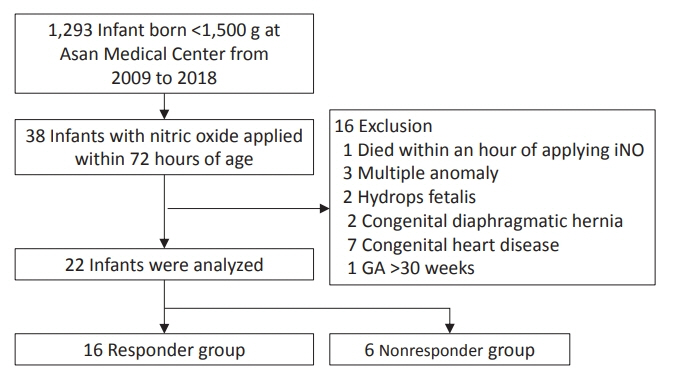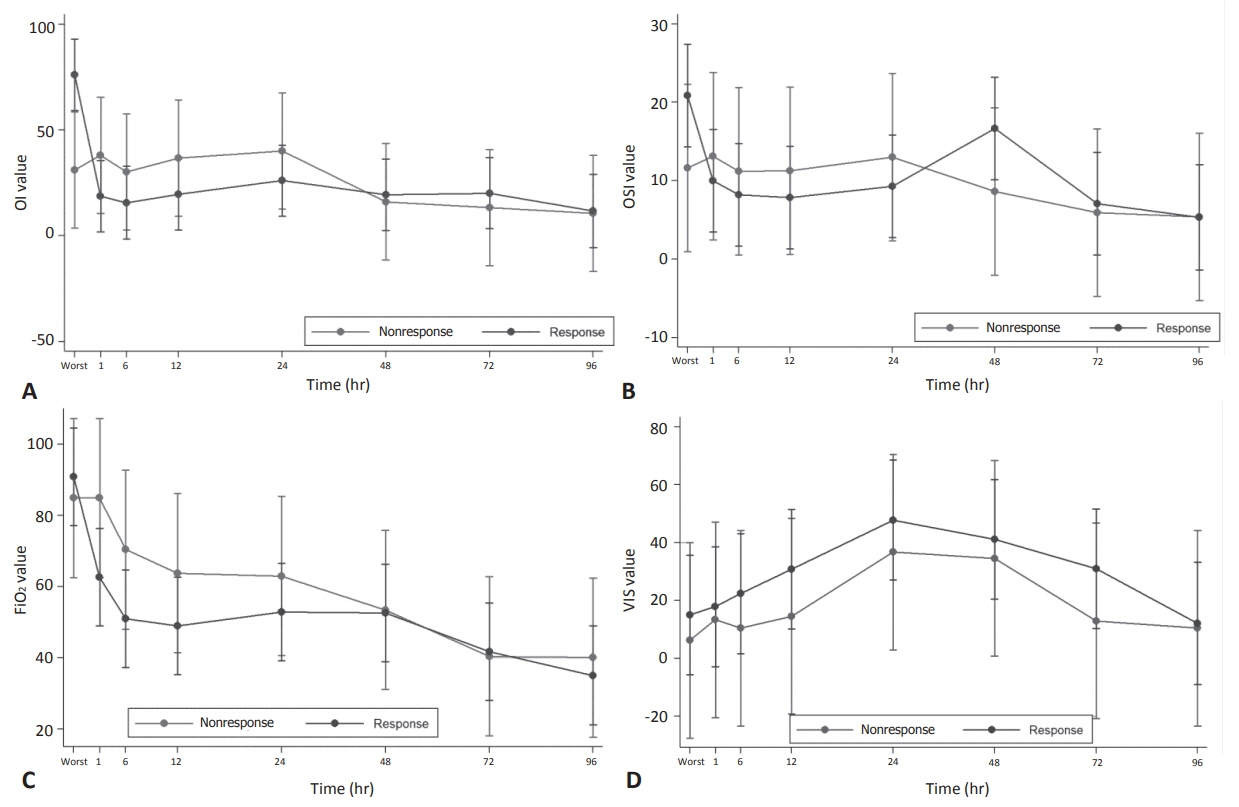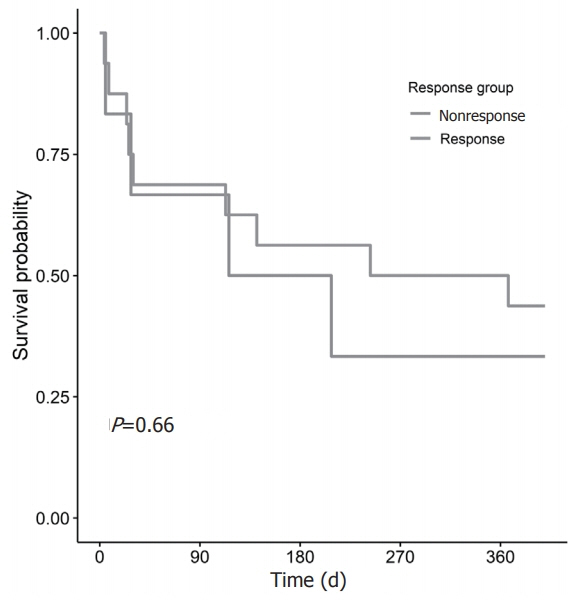Neonatal Med.
2020 Aug;27(3):133-140. 10.5385/nm.2020.27.3.133.
Response to Inhaled Nitric Oxide and Clinical Outcome in Very Low Birth Weight Infants with Early Pulmonary Hypertension
- Affiliations
-
- 1Department of Pediatrics, Gyeongsang National University College of Medicine, Jinju, Korea
- 2Department of Pediatrics, Asan Medical Center, University of Ulsan College of Medicine, Seoul, Korea
- KMID: 2505664
- DOI: http://doi.org/10.5385/nm.2020.27.3.133
Abstract
- Purpose
To determine the efficacy of inhaled nitric oxide (iNO) in very low birth weight (VLBW) infants with early pulmonary hypertension (PH).
Methods
We reviewed the medical records of 22 preterm infants who were born <30 weeks of gestational age with birth weight <1,500 g, diagnosed with early PH, and treated with iNO within the first 72 hours after birth. Responders were defined by a reduction in FiO 2 >20% and/or oxygenation index (OI) >20% from the baseline values at 1 hour after beginning iNO therapy. Cardiorespiratory support indices including OI, oxygen saturation index, and vasoactive-inotropic score (VIS) were serially obtained for 96 hours following iNO therapy.
Results
The mean gestational age of the patients was 26.1±2.0 weeks and the mean birth weight was 842±298 g. The mean OI at the start of iNO was 63.8±61.0. Impro vement in oxygenation indicated by prompt decrease in FiO 2 and OI from the base line values were observed 1 hour after beginning iNO therapy and lasted up to 96 hours. After iNO therapy, VIS increased until 24 hours and decreased thereafter. At 1 hour after iNO, 16 patients (73%) were classified as responders and six (27%) as nonresponders. Compared with nonresponders, responders did not demonstrate the beneficial effect of iNO in terms of short-term survival and neonatal complications. The 1-year mortality rate did not differ between responders (56%) and nonresponders (67%).
Conclusion
Although iNO treatment immediately improved oxygenation in most VLBW infants with early severe PH, the long-term mortality rate was high. A largescale study is needed to determine whether the initial response to iNO can predict patients’ survival.
Figure
Reference
-
1. Lakshminrusimha S, Saugstad OD. The fetal circulation, pathophysiology of hypoxemic respiratory failure and pulmonary hypertension in neonates, and the role of oxygen therapy. J Perinatol. 2016; 36 Suppl 2:S3–11.2. Barrington KJ, Finer N, Pennaforte T, Altit G. Nitric oxide for respiratory failure in infants born at or near term. Cochrane Database Syst Rev. 2017; 1:CD000399.3. Lakshminrusimha S, Keszler M. Persistent pulmonary hypertension of the newborn. Neoreviews. 2015; 16:e680–92.4. Kumar VH, Hutchison AA, Lakshminrusimha S, Morin FC 3rd, Wynn RJ, Ryan RM. Characteristics of pulmonary hypertension in preterm neonates. J Perinatol. 2007; 27:214–9.5. Nakanishi H, Suenaga H, Uchiyama A, Kusuda S; Neonatal Research Network. Persistent pulmonary hypertension of the newborn in extremely preterm infants: a Japanese cohort study. Arch Dis Child Fetal Neonatal Ed. 2018; 103:F554–61.6. Chambers CD, Hernandez-Diaz S, Van Marter LJ, Werler MM, Louik C, Jones KL, et al. Selective serotonin-reuptake inhibitors and risk of persistent pulmonary hypertension of the newborn. N Engl J Med. 2006; 354:579–87.7. Katz N, Bar-Or Y, Raucher-Sterrnfeld A, Tamir A, Kohelet D. Persistent pulmonary hypertension and histologic chorioamnionitis in preterm infants: controlled study. Pediatr Cardiol. 2018; 39:705–8.8. Gijtenbeek M, Haak MC, Ten Harkel DJ, Te Pas AB, Middeldorp JM, Klumper FJCM, et al. Persistent pulmonary hypertension of the newborn in twin-twin transfusion syndrome: a case-control study. Neonatology. 2017; 112:402–8.9. Dani C, Corsini I, Cangemi J, Vangi V, Pratesi S. Nitric oxide for the treatment of preterm infants with severe RDS and pulmonary hypertension. Pediatr Pulmonol. 2017; 52:1461–8.10. Kinsella JP, Steinhorn RH, Krishnan US, Feinstein JA, Adatia I, Austin ED, et al. Recommendations for the use of inhaled nitric oxide therapy in premature newborns with severe pulmonary hypertension. J Pediatr. 2016; 170:312–4.11. Barrington KJ, Finer N, Pennaforte T. Inhaled nitric oxide for respiratory failure in preterm infants. Cochrane Database Syst Rev. 2017; 1:CD000509.12. de Waal K, Kluckow M. Prolonged rupture of membranes and pulmonary hypoplasia in very preterm infants: pathophysiology and guided treatment. J Pediatr. 2015; 166:1113–20.13. Park GY, Park WS, Yoo HS, Ahn SY, Sung SI, Kim SS, et al. Shortterm outcomes comparison between preterm infants with and without acute hypoxic respiratory failure attributable to presumed pulmonary hypoplasia after prolonged preterm premature rupture of membranes before 25 gestational weeks. J Matern Fetal Neonatal Med. 2019; 32:1938–45.14. Ellsworth KR, Ellsworth MA, Weaver AL, Mara KC, Clark RH, Carey WA. Association of early inhaled nitric oxide with the survival of preterm neonates with pulmonary hypoplasia. JAMA Pediatr. 2018; 172:e180761.15. Lewis AB, Heymann MA, Rudolph AM. Gestational changes in pulmonary vascular responses in fetal lambs in utero. Circ Res. 1976; 39:536–41.16. Choi EJ, Sohn JA, Lee EH, Lee JY, Lee HJ, Choi CW, et al. The effect of inhaled nitric oxide in preterm infants less than 1,250 g with respiratory failure. Korean J Perinatol. 2011; 22:37–46.17. Rallis D, Deierl A, Atreja G, Chaban B, Banerjee J. The efficacy of inhaled nitric oxide treatment in premature infants with acute pulmonary hypertension. Early Hum Dev. 2018; 127:1–5.18. Bell MJ, Ternberg JL, Feigin RD, Keating JP, Marshall R, Barton L, et al. Neonatal necrotizing enterocolitis: therapeutic decisions based upon clinical staging. Ann Surg. 1978; 187:1–7.19. Papile LA, Burstein J, Burstein R, Koffler H. Incidence and evolution of subependymal and intraventricular hemorrhage: a study of infants with birth weights less than 1,500 gm. J Pediatr. 1978; 92:529–34.20. de Vries LS, Eken P, Dubowitz LM. The spectrum of leukomalacia using cranial ultrasound. Behav Brain Res. 1992; 49:1–6.21. International Committee for the Classification of Retinopathy of Prematurity. The international classification of retinopathy of prematurity revisited. Arch Ophthalmol. 2005; 123:991–9.22. Ehrenkranz RA, Walsh MC, Vohr BR, Jobe AH, Wright LL, Fanaroff AA, et al. Validation of the National Institutes of Health consensus definition of bronchopulmonary dysplasia. Pediatrics. 2005; 116:1353–60.23. Baczynski M, Ginty S, Weisz DE, McNamara PJ, Kelly E, Shah P, et al. Short-term and long-term outcomes of preterm neonates with acute severe pulmonary hypertension following rescue treatment with inhaled nitric oxide. Arch Dis Child Fetal Neonatal Ed. 2017; 102:F508–14.24. Chung SH, Bae CW. Improvement in the survival rates of very low birth weight infants after the establishment of the Korean neonatal network: comparison between the 2000s and 2010s. J Korean Med Sci. 2017; 32:1228–34.25. Day RW, Lynch JM, White KS, Ward RM. Acute response to inhaled nitric oxide in newborns with respiratory failure and pulmonary hypertension. Pediatrics. 1996; 98:698–705.26. Semberova J, O'Donnell SM, Franta J, Miletin J. Inhaled nitric oxide in preterm infants with prolonged preterm rupture of the membranes: a case series. J Perinatol. 2015; 35:304–6.27. Aikio O, Metsola J, Vuolteenaho R, Perhomaa M, Hallman M. Transient defect in nitric oxide generation after rupture of fetal membranes and responsiveness to inhaled nitric oxide in very preterm infants with hypoxic respiratory failure. J Pediatr. 2012; 161:397–403.28. Steinhorn RH. Advances in neonatal pulmonary hypertension. Neonatology. 2016; 109:334–44.29. Rawat M, Chandrasekharan PK, Williams A, Gugino S, Koenigsknecht C, Swartz D, et al. Oxygen saturation index and severity of hypoxic respiratory failure. Neonatology. 2015; 107:161–6.30. Muniraman HK, Song AY, Ramanathan R, Fletcher KL, Kibe R, Ding L, et al. Evaluation of oxygen saturation index compared with oxygenation index in neonates with hypoxemic respiratory failure. JAMA Netw Open. 2019; 2:e191179.
- Full Text Links
- Actions
-
Cited
- CITED
-
- Close
- Share
- Similar articles
-
- Inhaled Nitric Oxide as a Therapy for Pulmonary Hypertension after Operations for Congenital Heart Diseases
- The Therapeutic Effect of Inhaled Iloprost in Newborn Infants with Severe Persistent Pulmonary Hypertension Refractory to Inhaled Nitric Oxide
- Predictors of Clinical Outcome in the Newborns of Persistent Pulmonary Hypertension Treated with Inhaled Nitric Oxide
- Prognosis and Side Effects of Inhaled Nitric Oxide Treatment in Persistent Pulmonary Hypertension of the Newborn
- A case of persistent pulmonary hypertension of the newborn: Treatment with inhaled iloprost




